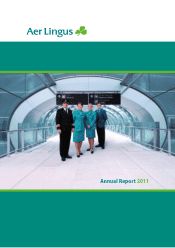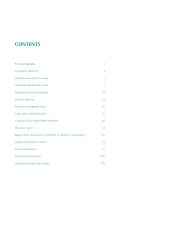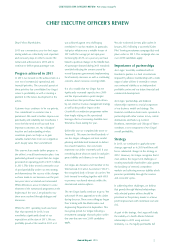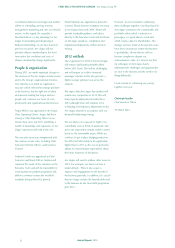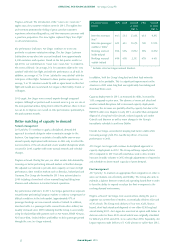Aer Lingus 2011 Annual Report Download - page 11
Download and view the complete annual report
Please find page 11 of the 2011 Aer Lingus annual report below. You can navigate through the pages in the report by either clicking on the pages listed below, or by using the keyword search tool below to find specific information within the annual report.
Annual Report 2011
OPERATING AND FINANCIAL REVIEW Aer Lingus Group Plc
As a result of the A330 disposal noted above, the long haul fleet
decreased by one aircraft. Aircraft numbers in the short haul fleet
remained stable with three A321 operating leased aircraft returned to
the lessor during the year while one A320 aircraft is currently held for
sale. These aircraft were replaced by the four newly delivered A320s
noted above.
As at 31 December 2011, Aer Lingus had 18 operating leased short
haul aircraft and 19 short haul aircraft which were either wholly
owned or held through finance leases, including one surplus A320 held
for sale. The Group had 7 wholly owned or financed leased long haul
aircraft as at the end of 2011.
The Group will introduce two leased A319 aircraft into the fleet in
early 2012 to replace operating leased A320 aircraft exiting the fleet.
The economics associated with the A319 aircraft type are appropriate
for some of the lower demand routes within the Aer Lingus network
and should drive further operating and cost efficiencies. Aer Lingus has
no current plans to significantly change short haul capacity deployment
in 2012. However, two additional leased A319s will join the fleet in
2013 to replace aircraft which are scheduled to exit the fleet as their
operating leases expire.
Key performance indicators: Our young fleet age continues to help us
drive a competitive unit cost position. Our average fleet age reduced
from 6.55 years to 6.18 years between December 2010 and December
2011. In addition, annual average fleet utilisation improved during the
year from 9.5 to 9.8 block hours per aircraft per day. This represents
an increase in utilisation of 1.4% and 10.8% in short haul and long
haul, respectively. These average annual utilisation levels reflect the
inherent seasonality of our business with much higher utilisation
achieved in the peak summer months.
2012 target: Aer Lingus will seek to maintain the current balance
between operating, owned and finance leased aircraft. At present, the
Group does not have any short haul aircraft order positions. This is not
currently an issue given the relatively young age of the short haul fleet.
However, in 2012, Aer Lingus will begin exploring its options for future
short haul deliveries. The Group currently expects to start taking
delivery of A350 long haul aircraft from 2015.
Focus on yields
Revenue per passenger
2011 priority: To continue to increase revenue per seat as a
cornerstone of Aer Lingus’ commercial strategy while recognising that
our principal competitor is Europe’s largest low cost / low fares airline.
Progress achieved: The installation of a newly enhanced revenue
management system, incorporating an updated Sabre module, has
improved our ability to forecast demand and optimise revenues.
Tactical capacity management has supported the continued growth in
revenue per seat. In addition, we have refined our product offering to
offer fare families that now focus explicitly on different market
segments:
Key performance indicators:
Our primary revenue management KPI is
revenue per seat. As a result of measures taken in 2011, we achieved a
5.5% increase in average fare per short haul seat and a 3.9% increase
in average fare per long haul seat. On a total network basis, this
represents a 4.7% increase in average yield per seat in 2011.
2012 target: Aer Lingus will target continued improvements in yield
per seat where conditions allow. Yield performance to date has been
supported by the change in pricing policy and augmented by the
introduction of new technology. Further yield improvements will build
on these foundations but will be challenging given current soft demand
conditions.
R
Re
et
ta
ai
il
l d
de
ev
ve
el
lo
op
pm
me
en
nt
ts
s
2011 priority:
To further develop the appeal of Aer Lingus’ retail
offerings and to build on the foundations established in recent years.
The Group’s continuing objective is to differentiate Aer Lingus through
the range, value and quality of its discretionary retail offering and to
provide customers with convenient travel options for which they would
be willing to pay. This approach is designed to allow Aer Lingus to
meet the needs of different segments of its passenger base and
maintain a broad appeal in our market.
Progress achieved:
In 2011, Aer Lingus refreshed its focus on retail in
order to improve revenue and margin. The Group improved its lounge
access product, initiated an improved advance seat selection option for
passengers and re-modelled its inflight catering choices under the “
Sky-
Deli
” brand. Also, we have improved the manner in which we
incorporate our retail offering into the on-line booking flow. Our new
O
Of
ff
fe
er
ri
in
ng
gD
De
es
sc
cr
ri
ip
pt
ti
io
on
n
Low • Enables Aer Lingus to compete on price.
•Provides passengers with free check-in and assigned
seating.
Plus • Enables Aer Lingus to compete on value.
• Provides passengers with a modular product
offering including checked bag, free advance seat
selection & Gold Circle points.
Flex • Enables Aer Lingus to target time sensitive
passengers.
• Provides passengers with flexibility and components
are targeted at the business traveller, e.g. two
checked bags, lounge access and refundable and
transferable ticket.
Fare revenue 2009 2010 Growth 2011 Growth
per seat (¤) vs. prior vs. prior
year % year %
Short haul 56.96 62.63 10.0% 66.09 5.5%
Long haul 187.29 238.58 27.4% 247.99 3.9%
Total network 70.58 78.62 11.4% 82.31 4.7%
9

